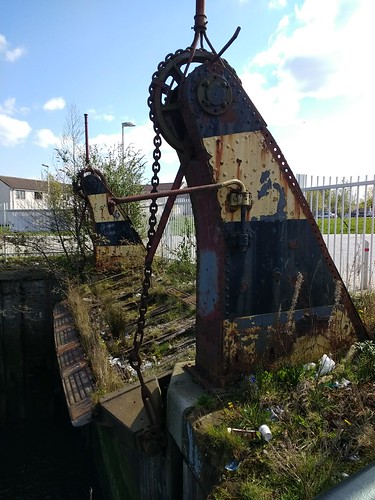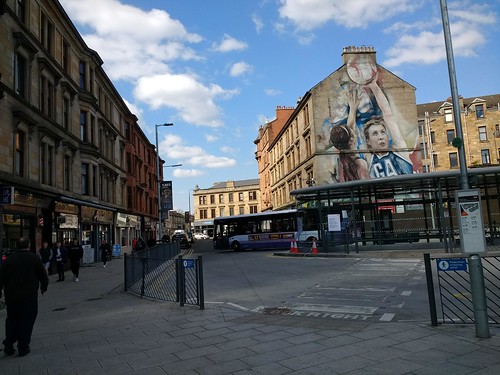The outward journey to Glasgow (described here) was on 9S47 which should have arrived in Glasgow at 13:15. Unfortunately, our arrival was about 13:59. Because I had already committed to a return service leaving Glasgow at 16:00 (pre-booking a particular train using an 'Advance' ticket can save significant sums of money), I'd insufficient time to carry out my planned excursion to Gourock on the Firth of Clyde. I reverted to my 'fallback plan' of a trip around Glagow's Subway.
Glasgow Subway brief history
Glasgow Subway has a fascinating history. Opened in 1896, it is the third oldest underground railway serving a city in the world (after London and Budapest), consisting of two iron-segment lined underground single-line tunnels arranged side-by-side as a continuous route six and a half miles long around the city, part north of the River Clyde, part to the south. Each tunnel carries a single 4 foot gauge track called Outer Circle (clockwise trains) and Inner Circle (anti-clockwise trains). The trains (initially single-carriage but with a second trailer carriage soon added) were originally cable-hauled by stationary steam engines. The carriages were electrically lit by a system feeding power to two rails (known as 'T-irons') mounted on the tunnel wall which was collected by wheels mounted on the side of the carriage. In 1935 the cable haulage was replaced by third-rail 600 volt d.c. electric traction (the original system of carriage lighting was retained with the collection wheels changed to 'skates'). In 1976, an ambitious modernisation plan introduced new trains, new signalling and a new maintenance depot. These changes served the city until 2019 when modernisation of all stations was completed and the first of a new fleet of trains built by Stadler arrived.
I hope to write more about this unique railway one day.

Map of Glasgow Subway (Strathclyde Partnership for Transport)
By Subway to Govan
Although Glasgow Central has two underground platforms (16 and 17), these serve Network Rail's 25 kV suburban network, not the Subway, so it's necessary to take a walk of a few minutes through the city to reach the nearest subway station - St. Enoch - offering the opportunity to admire some of Glasgow's stone-built architecture. According to Geocache (their website is here):-
"Sandstone is the dominant building stone type used in Glasgow. Two types of sandstone were generally used in the construction of the buildings - the so-called 'red' and 'blonde' sandstones. Many of city’s stone buildings were built in the second part of the 19th century and are now of an age where some of the stonework is showing signs of decay and require repair. The legacy of air pollution from industry and domestic coal burning through much of the 20th century has accelerated stone decay in many parts of the city."

Glasgow, Scotland
Strathclyde Geoconservation Group (part of the Geological Society of Glasgow) has produced an interesting 16-page booklet on the stone used in the city's buildings. Catchily titled 'Glasgow Rocks' they've made it available here.
St. Enoch Subway Station building is a rather eccentric design in stone, described as 'Flemish Renaissance' style, sited in the centre of St. Enoch Square. Originally, the passenger entrance was via the ground floor of the building with the offices of the subway on the upper floor but two new covered entrances have been provided, one 50 metres north, the other 50 metres south. The original building has been re-purposed as a branch of 'Caffe Nero'.

Former Glasgow Subway station building at St. Enoch - now a Caffe Nero: Glasgow, Scotland

Glasgow Subway: St. Enoch station following modernisation
Click for larger view
I entered St. Enoch via one of the modern covered entrances which reminded me of an oversize Slinky Toy (for those unfamiliar with this, Wikipedia have an interesting article here). This led me down to the long concourse joining the two covered entrances. Here I purchased a multi-trip ticket, then passed through an automatic ticket barrier and descended to the Outer Circle Platform. An Inner Circle train arrived at the opposite platform, displaying the sharply inward-curved upper panels of the coaches, necessitated by the small diameter tunnel bores. The livery of trains at that time included bright orange sections, giving rise the the line's informal title of 'Clockwork Orange' (a play on the title of Stanley Kubrick's 1971 dystopian film).

St. Enoch Subway Station - platform level (Glasgow Subway)
Boarding my Outer Circle train to travel seven stops to Govan, the restricted space inside was very apparent. I disembarked at Goven, a Burgh from 1864 to 1912 until absorbed by Glasgow. The burgh arms featured a ship flanked by shipyard workers with the motto 'Nihil sine Labore' - nothing without work. I crossed Govan Road from bus station, adjacent to the Subway station, and entered Water Street to reach the River Clyde, passing the splendid, restored Aitken Memorial Fountain. I afterwards found its interesting story here

The restored Aitken Memorial Fountain, Govan (Glasgow, Scotland)
At the river bank, I found the remains of the loading ramp of the Goven Ferry, a former vehicle ferry across the river. There's still a seasonal passenger ferry from an adjacent pontoon on the southern bank to a landing stage adjacent to the Riverside Museum on the northern bank but it wasn't operating during my visit.

Remains of loading ramp on south bank, Govan Ferry, Glasgow, Scotland
Looking across the Clyde the Riverside Museum, designed by Zaha Hadid, is a startling sight. It's a long five-bay warehouse but each bay has a different span and the gable roof of each bay a different height. Rather than retaining a rectangular footprint, the bays sweep in an asymmetric 'S'. This remarkable building, opened in 2011, now houses the transport collections based from 1964 in a disused tram depot in Pollockshields, moving to Kelvin Hall in 1987, which I visited once. The preserved Clyde-built sailing ship 'Glenlee' look rather incongruous against the backdrop of the Riverside Museum building. I'm afraid I'm not a fan of the ultra-modern and hadn't liked the architect's Heydar Aliyev Centre in Baku, Azerbaijan which I'd visited briefly at the end 2018 (report here).

View of River Clyde from Govan, looking upstream, showing Riverside Museum and 'Glenlee'
Looking downstream, all signs of Glasgow's engineering history had been removed and replaced by modern apartment blocks, so I decided to retrace my steps to Govan Subway station to continue my trip on the Subway.

View of River Clyde from Govan, looking downstream, showing modern apartments
By Subway to Partick
I determined to initially travel one stop to Partick, crossing under the River Clyde at a low point in the tunnels called 'The Sump'. There was a little wait before my Outer Circle train appeared.

Govan Subway Station - platform level (Glasgow Subway)
Partick has a modern, utilitarian building at street level. Like Govan, the bus station is just outside the entrance to the Subway.

View north on Merkland Street, Partick with bus station on right, Subway station behind camera (Glasgow, Scotland)
In addition to the Subway station and bus station, Partick station on Network Rail's 25kV suburban line is only yards away. I considered using this line to return directly to the underground platforms at Glasgow Central but there was a wait before the next service so I decided to return to the Subway station to complete my circuit of the subway.

Eastbound Platform waiting area at Partick Station, Glasgow
By Subway back to St. Enoch
I'd entertained the idea of getting off the Subway at Buchanan Street and walking to Network Rail's Queen Street station but, on that Saturday afternoon, the Subway service was fairly sparse and I realised I'd have to simplify my tour if I was to catch my booked Virgin return train so I stayed on the Subway train to St. Enoch and then walked back to Glasgow Central, pausing on Argyle Street, where this busy street passes under the railway station, to photograph the glazed side screen on the station overall roof.

View of Glasgow Central Station from Argyle Street showing glazed side screen on station overall roof
Making my way across the concourse to my train, I again admired the thoughtful architectural design, not yet ruined despite the modernising of general facilities and 'retail opportunities'. In particular, I delighted in the airy, light space provided by the huge, glazed overall roof, which reminded me of Waterloo station in London (I talked about Waterloo's roof approvingly in the post Waterloo Station, London (Part 2)).

Glasgow Central Station concourse
By Virgin Pendolino back to Wolverhampton
Once aboard the Virgin train, I was able to relax after my dash around the city. I continued to take pictures whilst the light held but I'm afraid they are poor. I haven't attempted to describe the long return journey which was fortunately without incident. It was an exhausting, but very satisfying, day.
Related Posts on other Websites
Glasgow Subway (Wikipedia).
Glasgow Subway (Strathclyde Partnership for Transport).
St Enoch subway station (Wikipedia).
Aitken Memorial Fountain.
Related Posts on this Website
The following post describes my outward journey to Glasgow:-
Glasgow by Rail
My pictures
Where necessary, clicking on an image above will display an 'uncropped' view or, alternately, pictures may be selected, viewed or downloaded, in various sizes, from the albums below:-
Pictures taken that day are divided between various albums:-
Glasgow by train.
Glasgow by rail (return).
Glasgow Central Station.
Glasgow Subway.
Scottish Railways.
Glasgow, Scotland.
